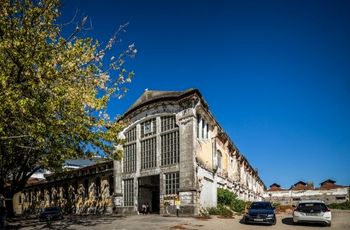The first phase of the works in the Campanhã Matadouro is complete

Porto.
· 03 Oct 2022
The first phase of the works in the Campanhã Matadouro is complete. The work, carried out by the company Mota-Engil, included cleaning the area, demolition, earthworks and surveys of the existing structures, in addition to experiments with the materials to be used in the reconstruction of the building. Japanese architect Kengo Kuma visited the iconic project, carried out in partnership with award-winning Portuguese architects from OODA, an office inspired by the famous Porto school of architecture. Both developed the concept that will be implemented in the Matadouro.
The reconversion and operation of the Old Industrial Matadouro of Porto, which has been awarded to the company Mota-Engil, aims to transform the building, deactivated for about 20 years, into an anchor facility in the rehabilitation of the eastern part of the city, based on the axes of social cohesion, economy and culture.
"It was the first time that the architect Kengo Kuma visited the Matadouro after the works began. It was a technical visit, to check the state of the work, which also served to choose, in some cases, the final finishing materials and colours to be applied. The constructor made a set of prototypes and today some decisions were taken regarding the final finishing of some spaces of the future Matadouro", underlined the town councillor for Urban Planning and Public Space, Pedro Baganha.
Opinion also shared by the CEO of Emerge-Mota Engil, Vítor Pinho: "He left very well impressed. He already knew the space and liked to see what was done. He is confident that it will be a new landmark in the city of Porto".
Born in Yokohama, a product of the Tokyo school of architecture, Kengo Kuma is the author of other objects of enormous importance for world architecture, such as the Suntory Museum of Art, in the Japanese capital, the Bamboo Wall House, in China, the headquarters of the Louis Vuitton Group, in Japan, the Besançon Art Center, in France, and, in particular, the new Tokyo National Stadium, which will host the opening ceremony of the 2021 Olympic Games.
Rehabilitation and construction of new buildings
The reconversion process began in May 2021, when Mota-Engil's excavating machines entered the old industrial complex and concentrated the work on the demolition of the elements in an advanced state of degradation.
It represents an investment of around 40 million euros, fully ensured by Mota-Engil, the northern private company that won the public tender launched by Porto City Hall. At the end of the 30-year concession, the equipment returns to the municipal sphere. The ceremony to sign the deed of consignment of the old Matadouro took place in October 2021, in the municipal equipment itself. Rui Moreira and Carlos Mota Santos, representing Porto City Council and Mota-Engil, respectively, signed the contract in the presence of the Prime Minister, António Costa.
The intervention programme foresees the complete reconversion of the complex, maintaining its historical memory and architectural nature, into diversified and multipurpose business spaces, commercial and leisure spaces for local support, spaces destined for social action and the connection with the local community and of a cultural and artistic nature, destined for the exhibition, production and deposit of art collections.
"We are going to start the rehabilitation phase of all the existing buildings and the construction of new ones. This phase will take about two years, and it is expected that in October 2024 the new Matadouro will already be at everyone's service," stressed the CEO of Emerge-Mota Engil.
In addition to the conversion, it is also planned to establish a public internal route that will allow circulation between the existing access on Rua de São Roque da Lameira and another direct access to the Dragão Metro station, crossing the interior of the main building, going up through a new building to be built at a height at the northern top of the complex, and crossing the VCI by means of a new overpass. This route should allow pedestrian and bicycle circulation. The car park adjacent to the Metro station will also serve the new Matadouro, bringing it closer to the city's main road and rail routes.
A new centrality in the city
The project also provides for a large roof that, in a single gesture, unites the old, which will be preserved, and the new finishing building, as well as the passage over the VCI, in a new centrality in the city. It will have 11 independent buildings, with four light fronts. The relationship between the interior and exterior office spaces will be made through garden areas. There will be the possibility to customise the interior of each building and to expand the company according to its needs.
At this moment, Mota-Engil has advanced to the marketing phase of the spaces and expressions of interest have already begun to appear.
Of the 20,000 square metres available for construction, 7,885 square metres will be under municipal management, with the rest being used by the entity that won the tender. It will be a sustainable building, with the installation of solar panels on the roof.
The complex will be sustainable and LEED certified. To highlight the nearly 2500m2 of solar panels on the roof for energy generation, as well as the use of efficient thermal, energy and water systems.
In addition to these, the future Matadouro will have a permanent cultural programme, to be developed by Porto City Council, with the possibility of creating synergies between different uses (workspaces/restaurants/cultural/social programme/events).


